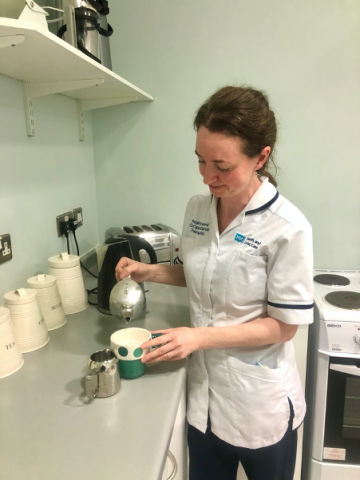Bronagh O’Kane and Claire Forde are Senior Occupational Therapists who support a range of patients in the Haematology Department at Northern Ireland Cancer Centre. Occupational therapists help stem cell transplant patients manage daily tasks including self-care, work, leisure, and tasks at home. Bronagh and Claire share their advice on how to look after yourself during hospital isolation and at home, as well as how Occupational Therapy can support you and your family.
We know that having a stem cell transplant can change your daily life and independence. How can occupational therapy help patients?
Our role becomes important when something like sickness interferes with someone’s daily activities or independence. We look at their daily activities, between getting up and going to bed, that are often taken for granted. From the simple things like getting out of bed, to enjoyable activities like hobbies.
Something we talk about with patients is the idea of having a bucket of coping mechanisms. When we’re sick, that bucket can be kicked over and things can spill out. The key thing is trying to maintain it, and topping it up by learning other ways of coping, such as dealing with anxiety through relaxation.
We’re also interested in someone’s ability to practise self-care, as well as their symptom and fatigue management. We can provide aids that help with saving energy, and support with adjusting to a hospital room during isolation.
Communication is so important, so we can be a listening ear. We want to motivate and encourage patients to find ways of continuing to engage in purposeful and meaningful activities.
Patients have many different healthcare professionals during their transplant journey. How do occupational therapists work with other members of the hospital team?
We have a liaising and communicative role. We are part of the multidisciplinary team, working alongside the medical team, nurses, physiotherapists, social workers, complementary therapists, dieticians and stem cell coordinators. We work closely with physiotherapy and can sometimes jointly work. We also can refer a patient to our art therapist or resident artist.
How can a patient look after their emotional wellbeing during their isolation period post-transplant?
It is important to acknowledge that recovering from a stem cell transplant can be a stressful time. We encourage patients to be as open and honest as possible about how they’re feeling. Being in isolation can heighten emotions – distraction techniques such a watching a boxset can take your mind off things and we can also provide talking therapies such as CBT (cognitive behavioural therapy).
Ultimately, it’s about not feeling overwhelmed, and challenging any negative thoughts. We can support patients with not feeling bombarded – for example, encouraging them to stagger visits from family and friends. It’s still important to maintain contact with friends and family, but to manage fatigue too. Coping with fatigue also involves being assertive, and letting your family know that you can only cope with short visits, for example.
If patients have a spiritual need, we can link in with their faith group. If they need further support, signposting to other charities and referring on to counselling can help.
What are the practical considerations for returning home from hospital after a stem cell transplant?
Our goal is for patients to return home to their similar circumstances. If they have physical needs, we can help with equipment or provide information on community resources such as rehabilitation schemes. We work closely with the social work team who can also provide support if needed.
As fatigue is one of the main side effects following a stem cell transplant, 'plan, pace and prioritise’ is a good way to look at it, to take time to do tasks at your pace in order to regain that sense of independence again. It’s important to focus on your recovery by balancing out activities so that your ‘new normal’ can include things you want to do, one at a time.
Do you have any advice for family members or friends who are supporting someone through a stem cell transplant?
There are several practical tasks that family or friends can assist with whilst the patient is in hospital, such as laundry, looking after the children if necessary, preparing frozen meals for when the patient is discharged home and looking after pets. Practical help can be beneficial.
A good idea is to have one designated point of contact in the family who can keep friends and family updated. Other family members or friends can visit the patient in hospital and engage with activities they enjoy such as watching films or play cards. Encouraging friends and family to stagger visits and being sensitive to the length of visiting time. For example, we had a patient whose brother helped him play video games as his hands were very swollen.
It’s important for family members to know there’s support for them too, so take advantage of resources and speak to your relative’s medical team if you need extra help.
You support a wide range of patients and their families. Is there a patient story that stands out for you?
There are a range that stand out. We learn so much from patients about how to best support them. People can be so inspiring. For example, young mothers away from their children can be so resilient. As much as we are there to help identify coping strategies, patients come up with their own amazing ideas. They know what works for them. Many people see a stem cell transplant as a lifesaving treatment and their resilience to get through to the other side is amazing.
